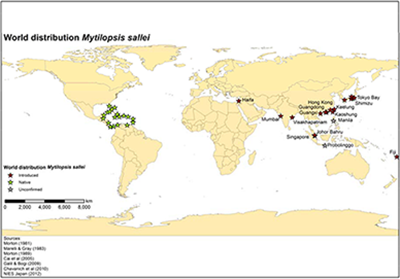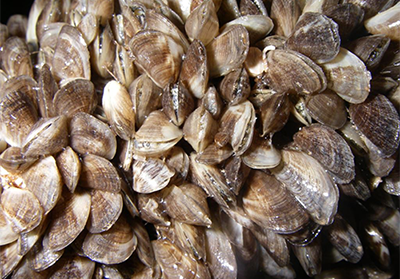Authors: Rupert Summerson, Maggie Skirtun, Kasia Mazur, Tony Arthur, Robert Curtotti and Robert Smart


In this report, Economic evaluation of the costs of biosecurity response options to address an incursion of Mytilopsis sallei (black-striped mussel) into Australia, ABARES compares eradication and containment costs to identify the most cost-effective way to respond to a hypothetical incursion of black-striped mussel (Mytilopsis sallei) in Australia. This invasive mussel species is increasingly widespread in ports throughout Asia, from the west coast of India to the north coast of Japan, and many of the infested ports involve seaborne trade with Australia.
This increases the risk of entry to Australia either as larvae in ballast water or as adults as fouling on ships' hulls. Black-striped mussel has the potential to cause significant economic and environmental damage should it become established and wide-spread in Australia.
Its high reproductive capacity and ability to form dense aggregations can result in severe impacts on port and aquaculture infrastructure, commercial and recreational vessels, marine ecosystems and the broader environment. These impacts and economic costs are likely to arise rapidly if a black-striped mussel incursion is left unmanaged, and could exceed the cost of any eradication or containment program.
The expected costs of eradicating an incursion of black-striped mussel were compared with the costs of containing an invasive population in the port where it arrived. The analyses were developed from 10 scenarios in four case study ports. The benefits were then estimated in terms of avoided market and non-market losses.
Damage to Australian ports and critical coastal infrastructure from an incursion of black-striped mussel was estimated to result in market losses ranging from $145 million to $286 million in present value terms over a 30 year period. Although not quantified in this study, potential non-market losses need to be added to this figure to determine the total economic costs. These are qualitatively assessed to be large and may possibly exceed market losses on the basis of a range of studies reviewed in this report for other invasive species.
The costs of eradication were estimated to range from $0.2 million to $118 million in present value terms for a horizon of 20 years and assuming a discount rate of 7 per cent. These are significantly lower than containment costs which were estimated to range from $9 million to $332 million.
The findings indicate that eradication is in most cases the preferred and less costly option than containment (Table 1), with the caveat that the likelihood of successful eradication will depend on early detection and response, preferably before the organism has had a chance to reproduce. However, neither of these eradication and containment options may be as cost-effective as preventative measures—which some overseas studies have identified as being the most cost-effective way to minimise the threat of invasive marine species introductions.
| Cost horizon | Discount rate(%) | Eradication($ million) | Containment to Port of Darwin ($ million) | Proportion of eradication costs to containment costs (%) |
|---|---|---|---|---|
| Estimated cost at 10 years | 3 | 42.48 | 273.21 | 15.5 |
| 7 | 230.02 | 18.5 | ||
| 10 | 204.82 | 20.7 | ||
| Estimated cost at 20 years | 3 | 42.48 | 455.17 | 9.3 |
| 7 | 332.37 | 12.8 | ||
| 10 | 272.73 | 15.6 | ||
| Estimated cost at 30 years | 3 | 42.48 | 590.56 | 7.2 |
| 7 | 384.40 | 11.1 | ||
| 10 | 298.91 | 14.2 |
Note: Eradication and containment costs expressed in 2012 dollars.
Download the full report
If you have difficulty accessing these files, visit web accessibility for assistance.
